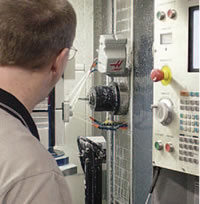
Contamination encompasses all of the things that end up in a coolant sump, other than water and coolant. The basics of contamination are liquids and solids.
The solid contaminates are typically metal chips and fines removed during machining. Out of the ordinary contamination sources such as sandwiches and tobacco chews can be removed by filtration.
Liquid contaminates are usually machine oils, hydraulic and way oils that drain into coolant sumps. You may also have specialty tapping fluids or other fluids that contaminate your coolant. You may or may not be able to remove these contaminates successfully with liquid separation techniques.
Control of contamination will allow your coolant to achieve peak performance with the minimal problems.
Solid contaminates provide enough surface area for bacteria to attach, often collecting in the sump to form deposits where coolant cannot circulate. The end result is known as a “dead zone”, which fosters high levels of bacteria growth.
Liquid contaminates, such as tramp oils, carry contaminates like sulfur, phosphorus, or solvents which can be detrimental to the coolant. Either by directly destabilizing the emulsion or by indirectly providing food for bacteria, liquid contaminates can severely impede performance.
If excessive tramp is allowed to cover a sump and seal off the surface of the coolant, oxygen will rapidly deplete. As a result, anaerobic bacteria begins to grow, ultimately producing the infamous “rotten egg” odor familiar to most machinists.
Filtration units of all types exist to continuously filter coolants. For central systems, careful sizing of the gallons per minute is necessary to obtain the desired results. For individual machines, portable filters can be rolled from machine to machine to extract solids. These portable units work well on individual machines, utilizing bag and cartridge filters.
Magnetic Separators can also be used on ferrous chips and swarf. These separators are regarded as excellent, economical metal removers.
When dealing with small chips, fine and grinding swarf filtration becomes even more important. This type of contamination can affect finishes and cause other tolerance issues.
The most common problem is tramp oil floating on the surface of the sump. Removal of the floating oil can be done with simple individual skimmers, to coallescers, to ultrafiltration devices. The simplest oil removal can be done with wet vacuums and oil-only absorbent pads. On individual machines, the use of disk and rope skimmers may also work.
Coalescers pump coolant to a still zone that allows the oil to separate and the clean coolant flows back into the sump. Typically they range in size from 1-2 gallon per minute units ($600) to 3-5 gpm units ($3500). Central systems with large volumes may need 25–50 gpm coalescing. Coolants differ in the amount and speed with which they split tramp oils. In many cases, coolants will emulsify the tramp oil or hold it in suspension. Skimming and coalescing will not work in this scenario.
More aggressive filtration with Ultrafilters will separate oil from water. Ultrafilters must be carefully specified to correctly separate your tramp oil, as it is possible to strip the coolant of oil and other additives.
As water evaporates it leaves behind the calcium, magnesium, silica and other dissolved solids. These substances lead to poor performance in all coolants. To control this you may elect to use distilled or deionized water for make-up. Do not use softened water, as the salts used to soften water can also cause problems with coolants.
|
ETNA Products 16824 Park Circle Drive, Chagrin Falls, Ohio 44023 Phone: 800-229-3862 / 440-543-9845 Fax: 440-543-1789 Copyright ©2025 ETNA Products, Inc. KOOLRite and SynMAX are trademarks of ETNA Products, Inc. |